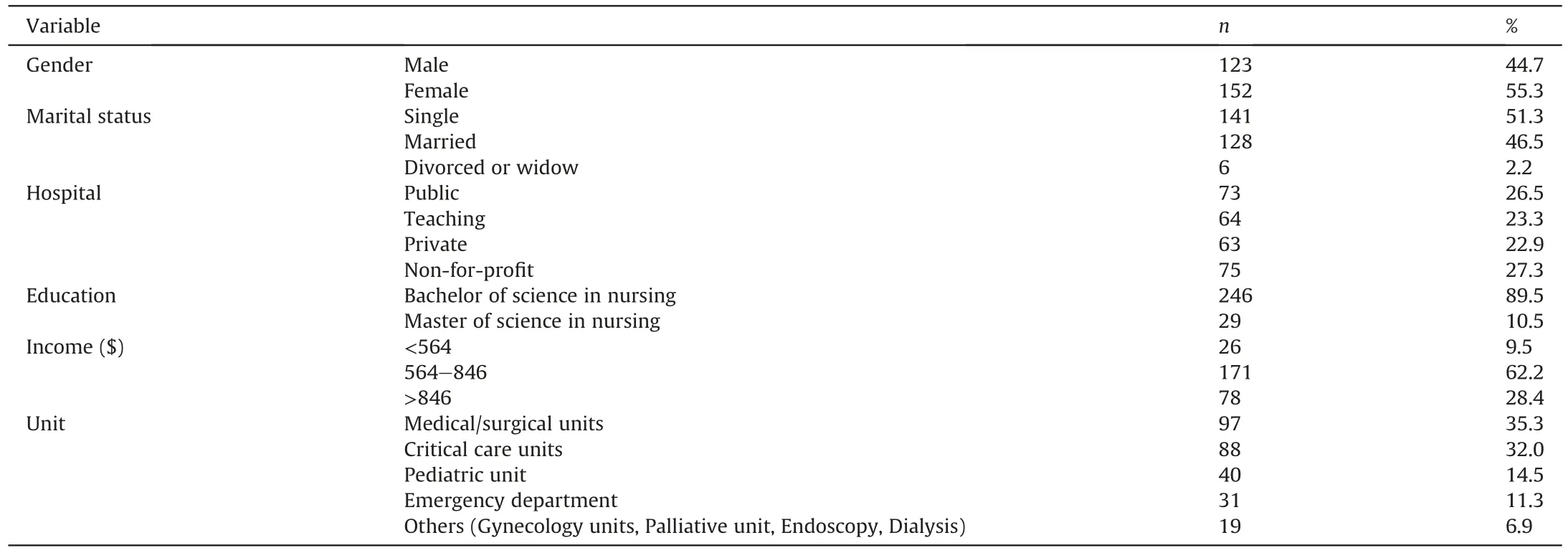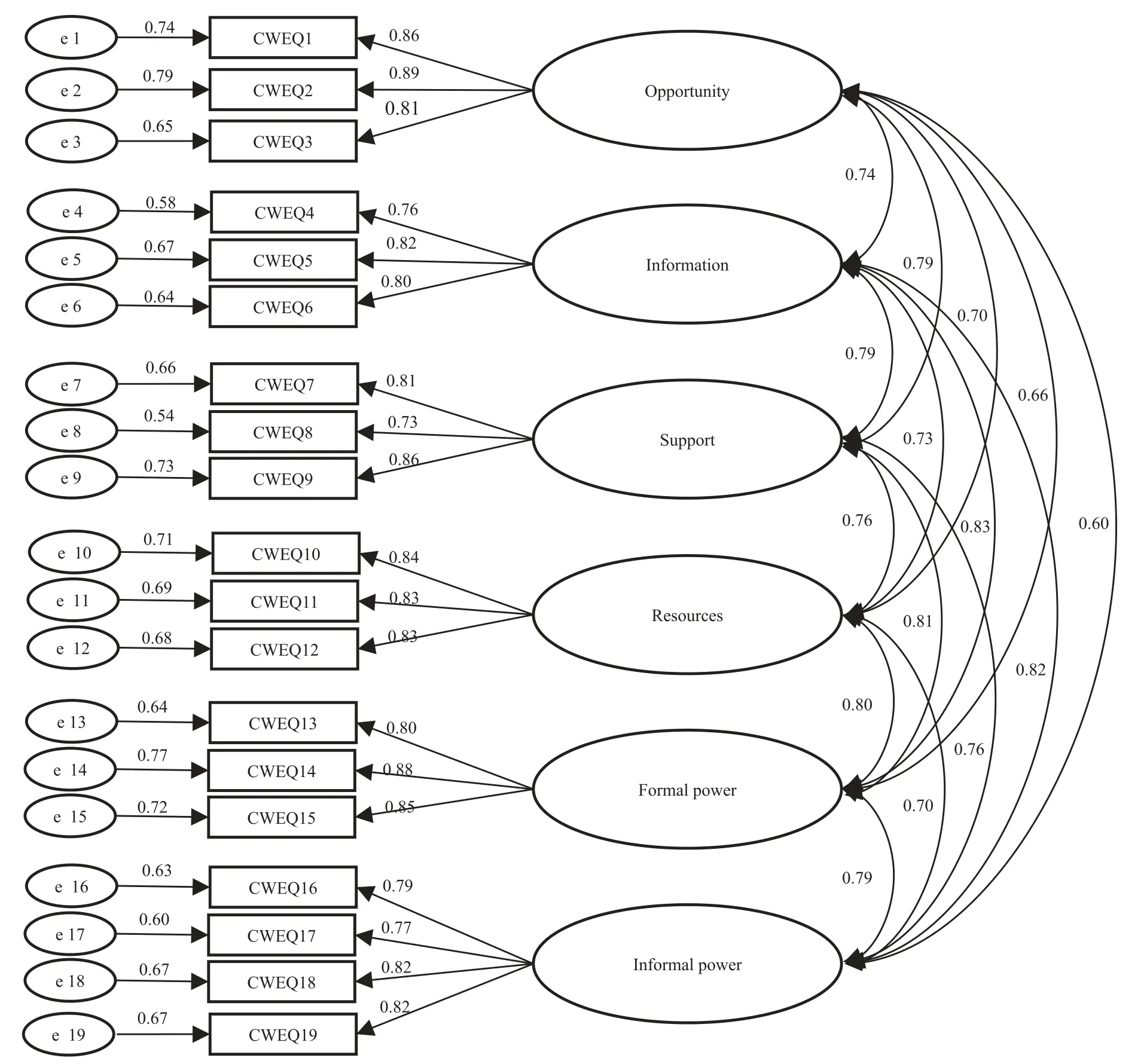Reliability and validation of the Arabic version of the Conditions for Workplace Effectiveness Questionnaire-II
2021-05-19WfMohmmedAlHmmouriJehdRhMohmmdSulimn
Wf’ F.T’n ,Mohmmed M.Al-Hmmouri ,Jehd A.Rh ,Mohmmd M.Sulimn
aDepartment of Community and Mental Health Nursing,Faculty of Nursing,Jordan University of Science and Technology,Irbid,Jordan
bDepartment of Adult Health Nursing,Faculty of Nursing,Jordan University of Science and Technology,Irbid,Jordan
cDepartment of Community and Mental Health Nursing,Faculty of Nursing,Al al-Bayt University,Mafraq,Jordan
ABSTRACT Objective:This study aimed to examine the psychometric properties of the Conditions for Workplace Effectiveness Questionnaire-II-Arabic Version (CWEQ-II-AV),which measures structural empowerment among nurses.To enhance the usability and credibility of the CWEQ-II among researchers within Arabicspeaking countries,a valid and reliable Arabic version of the measure is necessary.Methods:A cross-sectional research design was used.From December 2018 to June 2019,275 nurses working in 4 hospitals participated in the study.Reliability was assessed by examining internal consistency and split-half reliability.A confirmatory factor analysis was performed to evaluate the factor structure of the CWEQ-II-AV.Results:The psychometric properties of the CWEQ-II-AV were excellent regarding the six-factor model(opportunity,information,resources,support,formal power,and informal power).The results showed the following fit indices meet the criteria set a priori:comparative fit index (CFI)=0.96,root mean square of error approximation(RMSEA)=0.06,and χ2/df=2.08.Cronbach’s α coefficient was 0.95 for the total questionnaire and ranged between 0.83 and 0.89 for the individual subscales.The split-half reliability was 0.91 for the total questionnaire and ranged from 0.83 to 0.87 for individual subscales.Conclusion:This study provides evidence that CWEQ-II-AV is both a reliable and valid measure of structural empowerment among Arab nurses.
Keywords:Empowerment Hospital nursing staff Nursing administration research Psychometrics Jordan
What is known?
· Studying structural empowerment has become increasingly essential for its positive outcomes on patients,nurses,and organizational effects,such as increasing nurses’job satisfaction and organizational commitment.
· The Condition for Workplace Effectiveness Questionnaire-II(CWEQ-II) is a well-established tool created to measure structural empowerment among nurses.
· Although the English version of the CWEQ-II is considered a valid and reliable tool,the evidence of its psychometric properties among Arabic-speaking populations is absent,which hampers the conduct of structural empowerment research internationally.
What is new?
· The six-factor configuration of the Conditions for Workplace Effectiveness Questionnaire-II-Arabic Version (CWEQ-II-AV) is confirmed through confirmatory factor analysis.
· The CWEQ-II-AV has excellent goodness-of-fit indices supporting the questionnaire’s dimensionality to measure the concept of structural empowerment using the six subscales of opportunity,resources,information,support,formal power (job activity scale),and informal power (organization relationships scale).
· This study provides evidence that CWEQ-II-AV is both a reliable and valid measure of structural empowerment among Arab nurses.
1.Introduction
The Conditions for Workplace Effectiveness Questionnaire-II(CWEQ-II) is a study tool derived from Kanter’s work empowerment study [1].Chandler has modified the tool to be used in the nursing population by developing CWEQ-I [2].The CWEQ-I was then shortened into CWEQ-II and validated by Laschinger and colleagues [3].The CWEQ-II measures the concept of structural empowerment,defined as“the extent to which employees feel they have access to the structures in their work settings”[4].
Based on Kanter’s (1977) theory,work environments can be empowering by providing access to its structures,which are opportunity,information,resources,and support [1].Access to opportunity pertains to the prospect of development and growth and the opportunity to improve staff skills and knowledge.Access to information refers to the ability to acquire the knowledge needed to accomplish the job and understand organizational policies and decisions.Access to resources includes access to the equipment,time,and finance required to complete the work.Access to support refers to the availability of feedback,supervision,and consultations from peers,subordinates,and managers [1,4].
Formal and informal power systems influence access to these empowering structures in the organization.Formal power refers to allowing flexibility,creativity,and centrality in achieving organizational goals.Informal power refers to social connections and the development of effective relationships with superiors,peers,and subordinates within the organization [1].The CWEQ-II includes items measuring the four empowerment structures,the two sources of power,in addition to a two-item validation index that is listed as a global measure of empowerment.
Previous studies examined structural empowerment in patients,nursing,and organizational outcomes.Structural empowerment was found to be significantly associated with psychological empowerment among nurses [5-8].Besides,increased structural empowerment can enhance confidence,autonomy,a positive attitude and improve work impact [9].Other positive effects of structural empowerment on staff were manifested in the forms of increased job satisfaction[10-13],increased job performance[14],higher organizational commitment[15,16],and lower turnover and burnout rates [17,18].
Studies revealed that managers’ leadership styles play an important role and may positively impact structural empowerment within organizations,such as authentic or autocratic leadership style [19,20].The transformational leadership style,which focuses on the visionary and the big picture of the organization,has been found to have a substantial effect on structural empowerment[21,22].Affirming the strong relationship between structural empowerment and excellence in nursing and patient care,in 2008,the commission of Magnet Ⓡconsidered structural empowerment to be one of the five critical components in Magnet recognition[23].
Most of the previous research on structural empowerment was done in English-speaking countries,mainly Canada and the United States of America [24].The psychometric properties of the English version of the CWEQ-II were examined in a study conducted by Ref.[25],who reported a Cronbach’s α coefficient of 0.89,indicating sufficient internal consistency.Also,the subscales’ reliability coefficients ranged from 0.67 to 0.89,which implies moderate to excellent reliability.
The tool was widely used by nursing researchers,translating from English to other languages such as French,Chinese,Persian,and Portuguese.However,the tool was not yet translated and validated in the Arabic language [26].Although some studies examined structural empowerment in Arabic-speaking countries,the CWEQ-II was translated by the study’s researchers without validating these translated versions.Consequently,variations in the use of the questionnaire were exhibited.For example [27],conducted a study in Algeria,and when used,the researcher modified the questionnaire and used three subscales,namely,opportunity,support,and formal power.The study results reflected low to excellent reliability of these subscales (Cronbach’s α coefficient of 0.55 for the chance,0.84 for help,and 0.87 for informal power).
To enhance the usability and credibility of the CWEQ-II among researchers within Arabic-speaking countries,a valid and reliable Arabic version of the tool is necessary.This study aimed to examine the psychometric properties of the Arabic version of the CWEQ-II(CWEQ-II-AV).Establishing a valid and reliable tool that is understandable by participants will enhance the comparability and generalizability of the research findings [28].
2.Participants and methods
2.1.Design and participants
A cross-sectional research design was used to validate the measure of structural empowerment (CWEQ-II-AV) among Jordanian nurses.Polit and Beck (2016) stressed the importance of performing a psychometric study of a newly translated instrument to assure its reliability and validity [29].A cross-sectional design can study the associations among study factors and outcomes of interest[30].This research intended to investigate the dimensionality of the CWEQ-11-AV and its validity in measuring the concept of structural empowerment.Therefore,a cross-sectional design was used to allows the comparability of the study findings and,at the same time,how the study scale and its subscales correlate among the participants.From December 2018 to June 2019,a total of 275 nurses participated in the study.For maximum likelihood estimation,a sample of 100-400 is considered sufficient [31].The inclusion criteria were any registered nurse who has been working in their current location for the previous six months and full-time employment to ensure that the nurses are fully oriented about the conditions of the work environment in their hospitals.The study was conducted in four Jordanian hospitals;a university hospital,a not-for-profit hospital,a government hospital,and a private hospital to enhance generalizability.Hospitals were selected conveniently based on their bed capacity,number of registered nurses,and accessibility.
2.2.Instruments
The Condition for Workplace Effectiveness Questionnaire-II(CWEQ-II) is a 19-item tool used to measure structural empowerment among nurses [3].The questionnaire is divided into six subscales:opportunity,resources,information,support,formal power(job activity scale:JAS),and informal power (organization relationships scale:ORS).These subscales are measured using a 5-item Likert scale ranging from 1 to 5,where a higher score means better access to empowerment structures.Each subscale consists of 3 items,except for the last one (informal power),which includes four items.The overall structural empowerment is calculated by summing the scores of the six subscales.Total scores range between 6 and 30.Higher scores indicate higher perceived empowerment in the work environment.Scores from 6 to 13 represent low levels of empowerment,14 to 22 illustrate moderate levels of empowerment,and 23 to 30 are considered high empowerment levels.Participants’ self-reported sociodemographic data included age,gender,education,experience,income,and work unit.
2.3.Translation techniques
The WHO translation protocol was adopted in this study [32].The protocol includes forward translation,a panel of experts,back translation,pretesting and finalizing the translated questionnaire.First,permission from the questionnaire’s developers was obtained to solve and use the tool.Then,a panel of three professional bilingual experts participated in translating the CWEQ-II process.Initially,the tool was forward translated from English to Arabic by an experienced expert.Then,a second professional back-translated the Arabic version into English,independently from the first translator.After that,the original questionnaire and the backtranslated performance were compared for consistency in meaning by the third expert.The study authors discussed the translated tool’s semantic and conceptual integrity and evaluated the content validity of the translated measure.They also assessed the cultural appropriateness of the final version of the translated measure.The final CWEQ-II-AV was cognitively tested among 30 participants,who were then included in the final analysis.The cognitive testing aimed to assure the translate questionnaire’s understandability and cultural appropriateness[33].
2.4.Ethical considerations
Before data collection,ethical approval was obtained from the Institutional Review Board (IRB) of the affiliating university and data collection sites.Signed informed consent was obtained from each participant.Participants were assured that their anonymity and confidentiality would be preserved.They were also informed that their participation is voluntary,and they can withdraw from the study at any time.
2.5.Statistical analysis
Descriptive statistics were performed using IBM SPSS Statistics for Windows,Version 27.0.(Armonk,NY) to analyze participants’characteristics,nurses’ structural empowerment level,and structural empowerment subscales.The confirmatory factor analysis(CFA) was performed using AMOS (Version 26).Only CFA was conducted because the English version of the CWEQ-II had already been created and validated [3].To establish contrasted group validity,the participants were divided into three groups based on their reported income level.The data of the variables presented normal distribution(Shapiro-Wilk,P >0.05),and contrasted group validity was tested with a one-way ANOVA.We postulated that participants with different income levels would score differently on the CWEQII-AV.The Goodness-of-fit indices were used to assess the suitability of the model for the CFA analysis [29,34].The following cutoff values were used:root mean square of error approximation(RMSEA)≤0.07,comparative fit index(CFI)≥0.95,and Chi-Square/Degrees of Freedom(χ2/df)<5 representing absolute,incremental,and parsimonious fit,respectively.
3.Results
3.1.Sample characteristics
Table 1 summarizes the participants’ characteristics.A total of 275 nurses participated in the study,with a response rate of 89%of 310 possible respondents.The mean age in years was 27.83±4.35.The mean years of experience were 6.31±5.49.The mean number of assigned patients was 6.31 ± 5.49.
3.2.Descriptive analysis of the CWEQ-II
Overall,nurses in this study perceived their work environment as moderately empowering (19.32 ± 4.61) (Table 2).The highest empowerment was recognized in access to opportunity(3.43 ± 1.06),and the least perceived empowerment was with formal power (2.88 ±1.04).
3.3.Reliability
The CWEQ-II-AV has a Cronbach’s α coefficient of 0.95,supporting the internal consistency of the questionnaire.The Cronbach’s α coefficient for all subscales of the CWEQ-II-AV is presented in Table 2.The internal consistency was further assessed based on composite reliability (CR).Internal consistency is supported when the values of the CR are above 0.70[31].The results showed that all subscales of the CWEQ-II-AV have values that exceed this cutoff point.
3.4.Contrasted group validity
The one-way ANOVA test showed that the difference of structural empowerment scores among nurses with different income levels was statistically significant (F=11.62,P <0.001).The posthoc comparisons revealed that nurses with an income level of <564$/month have the lowest structural empowerment scores(P <0.0001).
3.5.Confirmatory factor analysis
A six-factor model was assessed(Fig.1),and the results showed that the fit indices meet the criteria set a priori:CFI=0.96,RMSEA=0.06,and χ2/df=2.08.Also,the GFI and AGFI values of this model were 0.90 and 0.86,respectively.All factor loadings were high,ranging from 0.73 to 0.89(Fig.1).These findings support the factor structure of the six-factor CWEQ-II-AV.The discriminant validity was assessed based on examining the correlations of the subscales and comparing them to the square root of the average variance extracted (AVE).Discriminant validity is supported when the AVE’s square root is higher than the inter-construct correlations[31].Table 3 summarizes the inter-construct correlations with the square roots of the AVE.The table shows that most of the subscales have values of the square root of the AVE exceeding the interconstruct correlations.
3.6.Measurement invariance
Three types of measurement invariance (multiple group analysis) were performed across the gender of participants:a) equal form (configural invariance),b) equality of factor loadings (metric invariance),and c) equality of indicator intercepts (scalar invariance).The results regarding equal form invariance showed that the fit indices for multiple group analysis(across participants’gender)are still within the criteria set a priori (RMSEA=0.05,CFI=0.95,χ2/df=1.64).Regarding the equality of factor loadings and intercepts,the results showed that the CWEQ-II-AV has statistically non-significant values with P values exceeding the cutoff point of 0.05 supporting equal factor loadings invariance (χ2=18.08,df=19,P=0.52,χ2=37.31,df=38,P=0.50).

Table 1 Socio-demographic characteristics of participants (n=275).

Table 2 Descriptive statistics of the six subscales and reliability of the CWEQ-II-AV(n=275).
4.Discussion
The studies aimed to examine the psychometric properties of the CWEQ-II-AV.As the first study to assess the factor structure of the CWEQ-II-AV,the findings can considerably increase the conduct of structural empowerment research in Arabic-speaking populations.This study’s participant demographics are similar to previous studies that reflect the young age of Jordanian nurses(average 28 years) and the close-ratio between male and female nurses [35].A moderate level of structural empowerment was perceived by Jordanian nurses,which is similar to what nurses reported in a previous study on 412 Canadian nurses [25],and another survey of 645 Egyptian nurses [36].
The psychometric properties of the CWEQ-II-AV were excellent regarding the six-factor model,and the results showed that the fit indices meet the criteria set a priori:CFI=0.96,RMSEA=0.06,and χ2/df=2.08.These results are comparable with the ones reported in the original instrument’s validation study (GFI=0.98,AGFI=0.89,RMSEA=0.13 [25].In the Persian version validation study,the same six-factor model was incorporated in the CFA,resulting in an acceptable fit for the model (CFI=0.92,RMSEA=0.06,GFI=0.94,and adjusted GFI=0.91) [37].The Chinese version’s validation used exploratory factor analysis and principal component analysis (PCA) with varimax rotation to examine the factor structure of the scale.The PCA showed that six factors collectively accounted for about 72% of the variance.Wood and Harber (2002) indicated that factor analysis should ideally explain 40%-60% of the variance [38].
To measure the instrument’s internal consistency,Cronbach’s α coefficient was calculated for the total score of the CWEQ-II-CV and the subscales(Table 3).The Cronbach’s α coefficient for the overall score and subscales of the Arabic,English[25],Chinese[39],Persian[37],and Portuguese[40]versions were 0.95(subscales 0.83-0.89),0.89 (0.67-0.89),0.92 (0.68-0.86),0.84 (0.71-0.87),0.91(0.68-0.89),respectively.These results indicate that CWEQ-II is a valid measure that can detect structural empowerment among nurses from different cultural backgrounds.On the other hand,an Algerian study,which included 59 nurses and measured structural empowerment using Arabic translated CWEQ-II with only three subscales,reported lower internal consistency than our study[27].They reported Cronbach’s α coefficient for the total score,formal power,support,and opportunity as 0.86,0.86,0.84,0.55,respectively.However,the Algerian study aimed to examine the effect of structural empowerment on psychological empowerment rather than examine the tool’s psychometric properties,and they used a comparably low sample size.
5.Strength and limitations
This study was conducted using a cross-sectional design which limits the generalizability of the findings.The study participants were recruited from public,private,teaching,and not-for-profit hospitals in Jordan.However,further investigation of the psychometric properties of the CWEQ-II-AV among other Arabic-speaking populations is warranted.Also,test-retest reliability was not performed considering the cross-sectional nature.We recommend that future researchers investigate the test-retest reliability of the CWEQ-II-AV.
6.Conclusions
This study provides evidence that CWEQ-II-AV is both a reliable and valid measure of structural empowerment among Arab nurses.The excellent goodness-of-fit indices for the CWEQ-II-AV support the questionnaire’s dimensionality to measure the concept of structural empowerment using the six subscales of opportunity,resources,information,support,formal power (job activity scale)and informal power(organization relationships scale).As CWEQ-IIAV is ready for use in Arabic-speaking countries,further research is needed to study the variables contributing to structural empowerment and develop and evaluate empowering nurses’ strategies.Increasing access to empowerment structures is essential to yielding highly responsible and autonomous nurses who strive to provide high-quality nursing care.

Fig.1.The six-factor model of the Conditions for Workplace Effectiveness Questionnaire-II-Arabic Version(CWEQ-II-AV)

Table 3 The correlations and the Cronbach’s α values for the CWEQ-II-AV.
Funding
No funding.
Ethical approval
Obtained from Institutional Review Board of Jordan University of Science and Technology(IRB reference number:461/2019).
CRediT authorship contribution statement
Wafa’a F.Ta’an:Conceptualization,Project administration,Methodology,Writing-original draft preparation,Writing-review&editing.Mohammed M.Al-Hammouri:Conceptualization,Data curation,Writing-original draft preparation,Writing -review &editing,Validation.Jehad A.Rababah:Visualization,Methodology,Investigation,Data curation,Formal analysis,Writing-original draft preparation.Mohammad M.Suliman:Methodology,Resources,Writing-review&editing.
Declaration of competing interest
The authors declare no competing interests.
Acknowledgement
The authors are thankful to Jordan University of Science and Technology and the Deanship of Scientific Research for supporting this research.
Appendix A.Supplementary data
Supplementary data to this article can be found online at https://doi.org/10.1016/j.ijnss.2021.03.011.
杂志排行
International Journal of Nursing Sciences的其它文章
- Associations between risk factors for cardiovascular diseases and frailty among community-dwelling older adults in Lanzhou,China
- Supplement to the published paper“Theory-guided interventions for Chinese patients to adapt to heart failure:A quasi-experimental study”
- Lived experiences of the disease journey among patients with idiopathic pulmonary fibrosis
- Persistent effect of nurse-led education on self-care behavior and disease knowledge in heart failure patients
- Using action research to evaluate a nursing orientation program in a multicultural acute healthcare setting
- Effects of a theory of planned behavior-based intervention on breastfeeding behaviors after cesarean section:A randomized controlled trial
